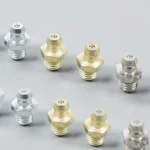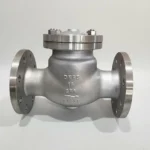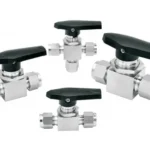À primeira vista, os dois podem parecer semelhantes, e é fácil confundi-los em sistemas de controle industrial. Entretanto, as válvulas de instrumentação e os manifolds de instrumentos diferem significativamente em termos de estrutura e função. No campo em evolução da instrumentação industrial, a precisão e o controle são fundamentais.
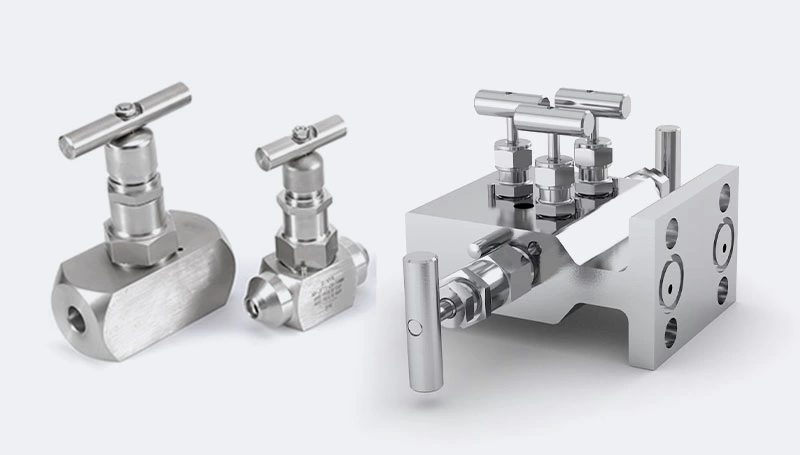
As válvulas de instrumentação não são iguais aos manifolds de instrumentação. Uma válvula de instrumentação é uma válvula única usada para isolar ou ventilar instrumentos de pressão (como medidores ou transmissores). Um coletor de instrumentos - também conhecido como coletor de válvulas - é um conjunto modular composto de várias válvulas, projetado para sistemas de medição e controle mais complexos, especialmente em configurações de pressão diferencial. Embora ambos sejam usados com instrumentos, eles têm finalidades diferentes.
Este artigo explora os casos de uso clássicos de cada componente e analisa as diferenças entre os dois. Seu objetivo é distingui-los claramente e proporcionar clareza para qualquer pessoa que esteja navegando no complexo mundo das válvulas de instrumentação.
Entendendo as válvulas manométricas
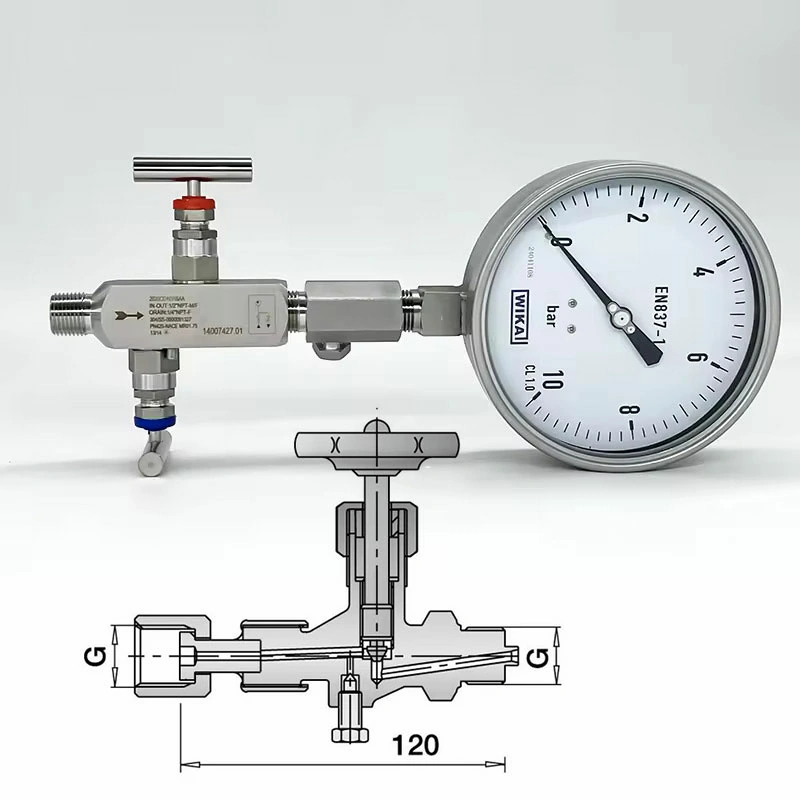
Válvulas de instrumentação são indispensáveis para conectar tubulações a instrumentos. Eles são usados para isolar, ventilar ou calibrar instrumentos de pressão. Elas permitem a abertura e o fechamento controlados dos medidores de pressão, facilitando a manutenção ou a substituição dos instrumentos a jusante. Algumas válvulas de instrumentação incluem portas de drenagem para liberar a pressão e drenar a linha durante a substituição.
As válvulas de instrumentação são normalmente válvulas do tipo agulha projetadas para o controle fino do fluxo de fluido. A estrutura inclui um corpo de válvula, haste, castelo e manopla. Seu tamanho compacto e mecanismo simples as tornam ideais para instalações com restrições de espaço.
Explorando os Manifolds de Instrumentos
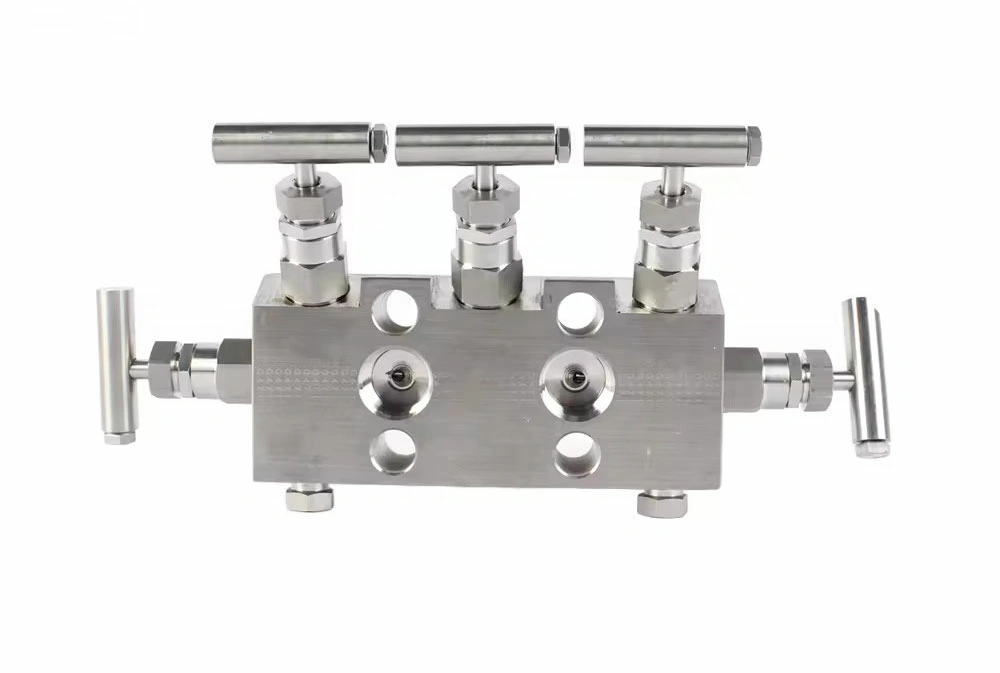
Um coletor de instrumentos integra várias válvulas de instrumentação em um conjunto de válvula composto. Isso permite que vários instrumentos de precisão (como transmissores de pressão ou de pressão diferencial) sejam conectados e controlados com mais eficiência. Os manifolds proporcionam isolamento, equalização e ventilação mais abrangentes e flexíveis nos sistemas de processo. Os tipos comuns incluem manifolds de 2 válvulas, 3 válvulas e 5 válvulas.
- Manifolds de 2 válvulas: isolamento e ventilação
- Coletores de 3 válvulas: adiciona equalização para sistemas de pressão diferencial
- Distribuidores de 5 válvulas: inclui duas válvulas de isolamento, uma válvula de equalização e duas válvulas de ventilação/teste para recursos adicionais de calibração e manutenção
Os manifolds de instrumentos são adequados para aplicações mais amplas de controle de sistemas. Eles são projetados para operações multifuncionais sem interromper o fluxo do processo primário, oferecendo flexibilidade operacional, especialmente em ambientes industriais complexos.
Diferenças entre válvulas de instrumentação e manifolds
Embora ambos sejam usados com instrumentos em tubulações, eles diferem notavelmente em estrutura e função.
- Função: As válvulas de instrumentação são mais simples e fornecem isolamento ou controle de pressão para um único instrumento. Os manifolds oferecem funções integradas como isolamento, equalização, ventilação e drenagem.
- Estrutura: Uma válvula de manômetro controla um único caminho de fluxo usando mecanismos básicos como agulha, esfera ou globo. Em contrapartida, um manifold contém várias válvulas interconectadas em um único corpo.
- Aplicativo: As válvulas de manômetro são adequadas para configurações básicas para proteger instrumentos de pressão individuais. Os manifolds são usados em processos de automação mais complexos, de alta precisão e críticos para a segurança.
Tabela de comparação: Válvula de Instrumentação vs. Manifold de Instrumento
| Recurso | Válvula de medição | Manifold de instrumentos |
| Estrutura | Válvula única, normalmente do tipo agulha | Conjunto de várias válvulas (por exemplo, 2, 3 ou 5 válvulas) |
| Função principal | Isolamento, ventilação, calibração | Isolamento, equalização, ventilação, teste |
| Instrumentos adequados | Medidores de pressão, transmissores | Transmissores diferenciais, medidores de vazão |
| Complexidade da instalação | Simples, direto | Mais complexo, multifuncional |
| Conveniência de manutenção | Fácil de substituir, baixa manutenção | Ciclos mais longos, suporte multifuncional |
| Casos de uso típicos | Pontos básicos de medição de pressão | Sistemas diferenciais, pontos de controle de processo |
| Complexidade de controle | Baixa | Alta |
| Caminhos de fluxo | Individual | Vários caminhos (entrada, saída, ventilação) |
| Materiais comuns | Aço inoxidável, latão | Aço inoxidável de alta qualidade, ligas especiais |
| Custo | Inferior | Mais alto |
Importância no controle de processos

As válvulas de instrumentação e os manifolds são mais do que simples conectores - eles são essenciais para garantir a segurança e a estabilidade do sistema. Na prática, ambos os componentes ajudam a evitar vazamentos, garantem a coleta precisa de dados e dão suporte ao controle multifuncional. Eles atendem às demandas industriais modernas por operações seguras, inteligentes, eficientes e precisas.
Em setores com altos requisitos de segurança - como petroquímico, energia e gás natural - elas oferecem aos engenheiros maior precisão de controle e capacidade de resposta a emergências. A Walter Valve tem o compromisso de atender aos sistemas de controle de processos com produtos confiáveis e de alto desempenho que ajudam os clientes a criar soluções de automação mais seguras e com maior eficiência energética.
Classificações de pressão e desempenho
Ao selecionar uma válvula de instrumentação ou um coletor, Classificações de pressão e especificações de desempenho são considerações importantes para atender a condições exigentes. Dependendo da aplicação, os requisitos de pressão variam. As válvulas de instrumentação normalmente operam entre 3000 psi e 6000 psi. Em ambientes mais severos, os manifolds podem precisar suportar pressões ultra-altas.
Além da resistência à pressão, as válvulas e os manifolds devem oferecer excelente vedação, resistência à corrosão e adaptabilidade à temperatura. As válvulas de instrumentação da Walter Valve são amplamente fabricadas em aço inoxidável de alta qualidade (como SS316) ou aço carbono, oferecendo resistência mecânica e resistência à corrosão. Elas mantêm a vedação estanque e a operação responsiva sob temperaturas extremas (de -40°C a +230°C).
Caso de uso industrial: Indústria petroquímica

O setor petroquímico está entre os mais exigentes em termos de tecnologia de válvulas. Os processos químicos complexos, os meios corrosivos e as variações extremas de temperatura exigem muito do desempenho das válvulas, principalmente da resistência à pressão e da proteção contra corrosão.
No refino e no processamento de gás natural, as válvulas de instrumentação são usadas para conectar transmissores de pressão e medidores de fluxo diferencial, garantindo o controle preciso do meio e o isolamento seguro.
Nas unidades de destilação de petróleo bruto, os coletores de 3 ou 5 válvulas conectam transmissores diferenciais e outros instrumentos de precisão para permitir a coleta de dados precisos e em tempo real, o monitoramento on-line da tubulação, alarmes automáticos, ventilação e calibração seguras.
Válvula Walter são amplamente adotados nas principais refinarias, terminais de GNL e fábricas de produtos químicos. Eles ajudam os clientes a garantir a precisão da medição e, ao mesmo tempo, aumentam a segurança e a confiabilidade do sistema. Com prazos de entrega curtos, desempenho estável e configuração flexível, ajudamos a reduzir os riscos de paralisação e a aumentar a estabilidade operacional.
Conclusão
Para projetos de engenharia, compreender as diferenças entre válvulas de instrumentação e manifolds é fundamental para projetar sistemas mais seguros e eficientes. Embora ambos sejam amplamente usados em medição e controle industrial, eles diferem fundamentalmente em estrutura, função e aplicação. A primeira se concentra no isolamento de ponto único e no controle simples; a segunda integra várias funções e a conectividade do sistema - especialmente essencial em cenários de alta precisão.
Se tiver alguma dúvida sobre a seleção de válvulas, estoque ou especificações técnicas, entre em contato com nossos consultores de engenharia em info@waltervalves.com.
PERGUNTAS FREQUENTES
As válvulas de instrumentação e os manifolds podem ser usados de forma intercambiável?
Não recomendado. Eles diferem significativamente em estrutura e função. As válvulas são para pontos de medição simples; os manifolds são para aplicações diferenciadas e multifuncionais.
Para quais sistemas os manifolds são mais adequados?
Principalmente para sistemas de alta precisão, como transmissores de pressão diferencial e medidores de vazão de pressão dupla, oferecendo isolamento, equalização e ventilação.
A Walter Valve oferece suporte a produtos personalizados?
Sim. Personalizamos de acordo com seus parâmetros técnicos, incluindo tamanho da porta, classificação de pressão, material e muito mais.
Como posso determinar a classificação de pressão correta?
Baseie-se na pressão máxima de trabalho de seu processo e aplique um fator de segurança para selecionar um modelo classificado acima dessa pressão.
Os produtos estão em conformidade com os padrões internacionais?
Sim. Os produtos da Walter Valve atendem às normas ASME, ANSI, ISO e outras, com certificações de terceiros.
Qual é o prazo de entrega típico?
Mantemos um amplo estoque. Os modelos padrão são enviados em 3 a 5 dias; os modelos personalizados normalmente levam de 7 a 15 dias.

